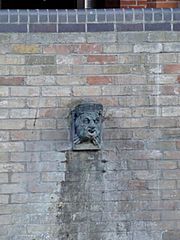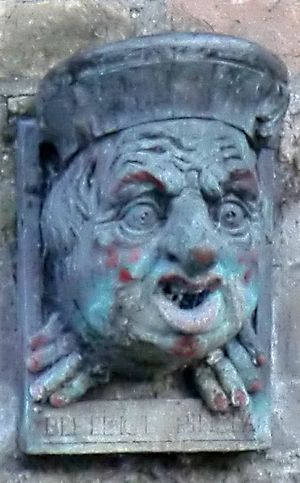Benedict Spinola facts for kids
Benedict Spinola (1519/20 – 1580) was a successful merchant from Genoa, Italy. He spent most of his adult life in London, England, which was a very important port city. Benedict started his career as a clerk and worked his way up to become a major trader. He exported wool clothes and imported wines. He also helped the English government as an agent and a financier, which means he managed large sums of money.
Benedict Spinola never married. He sadly died from the plague in London in August 1580, shortly after returning from a trip to the Netherlands.
Contents
Early Life and Business
Benedict Spinola, also known as Benedick Spinola or Benedetto Spinola in Italian, was born in Genoa. He was the second son of Battista Spinola and Elisabetta Spinola. His family was very important in Genoa. In fact, in 1556, Benedict's father was offered the chance to become the Doge, which was like being the leader of the city, but he turned it down.
Not much is known about Benedict's very early life. By 1541, when he was around 21, he was already working in London. He started as a clerk for Bastian Bony, who handled mail for foreign merchants in the City of London. Benedict lived his entire adult life in the area of St Gabriel Fenchurch. Later, his nephews, Hannibal and Ascaneo Spinola, joined him there. He owned a property in Shoreditch that was called "Spinola's pleasure."
Becoming an English Merchant
It was quite unusual for a foreigner to become a full English citizen back then, but Benedict Spinola did in 1552. This was a big deal because it meant he could pay the same taxes and customs fees as English people. This saved him a lot of money when trading. By 1559, he was a busy merchant, sending woollen cloths out of England and bringing wines into the country.
Benedict was very clever with business. In 1561, he admitted to using his own special license to export goods for another trader, John Justiniano. This allowed Justiniano's goods to be taxed at the lower English rate, saving them both money. Even after this, in 1566, he was officially given the right to do this with his license. He traded with his three brothers, Giacomo, Francisco, and Pasquale Spinola, who lived in Antwerp. In London, he was known as a very important merchant. For example, when the Earl of Leicester wanted fancy wall hangings for his home, Kenilworth Castle, he was told to go to Spinola because he could "get such stuff better cheap than any man." In 1572, the Earl of Leicester even called Spinola "my dear friend and the best Italian I know in England."
Adviser to the Government
Around 1550, Benedict Spinola was not happy with the minister of the Italian church in London, Michelangelo Florio, who was speaking against Catholics. However, by 1566, the Spanish ambassador in London reported that Spinola had joined the Church of England. In 1568, Benedict and his household were attending services at their local church.
Benedict became a trusted adviser to the English government. He helped by gathering important information from people overseas and by dealing with big financial matters. By the 1570s, he was handling huge amounts of money for the government.
In 1568, French Huguenot raiders forced ships carrying silver into English ports. This silver was a loan from Genoese merchants meant to pay soldiers for the Duke of Alba. To keep the silver safe, it was brought ashore. Spinola then worked for the English government to make sure the Genoese merchants were repaid.
Official Recognition and Loans
In 1568, during a special visit by heralds (officials who record family histories and symbols) to London, Spinola showed documents proving his family's importance. One certificate from Genoa confirmed he was the son of Baptiste Spinola, who had the right to use his family's coat of arms. Another certificate from the Earl of Bedford confirmed that in 1566, Benedict's father, Baptiste, had refused to become the Duke of Genoa.
In the same year, Queen Elizabeth I created a new company called the Society of Mines Royal. This was a joint stock company, meaning many people invested in it. Spinola was named as one of the main founders, along with important figures like the Earl of Pembroke and the Earl of Leicester. In 1571, Spinola and another merchant, Lionel Duckett, together loaned Queen Elizabeth I a large sum of £4,100. In 1578, Spinola also helped arrange an English loan to the Union of Brussels.
Magdalene College Gargoyle

On June 15, 1580, Benedict Spinola sold a building and about 7 acres of land in London to the Earl of Oxford for £2,500. This land, called the Great Garden of Christchurch, had previously belonged to Magdalene College, Cambridge. Magdalene College felt they had been tricked and tried to get the land back through legal actions, but they were not successful.
More than 400 years later, in 1989, Magdalene College decided to get a bit of revenge! They put up a gargoyle (a decorative stone carving, often shaped like a monster) that looked like Spinola. This gargoyle was designed by Peter Fluck and Roger Law, who were famous for creating the satirical puppet show Spitting Image.
Death
On July 6, 1580, after returning from a financial mission to the Netherlands, Benedict Spinola made his will in Italian. He stated that he was not well. On August 15, he died from the plague. He was buried in the choir area of St Gabriel Fenchurch church. Sadly, this church was later destroyed in the Great Fire of London and was never rebuilt.


